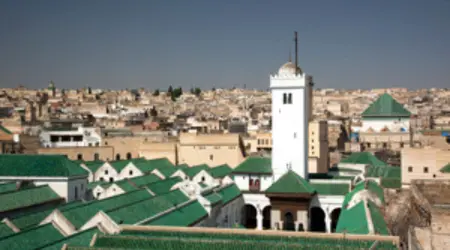La historia oculta de la primera universidad del mundo

El La historia oculta de la primera universidad del mundo Desafía la narrativa eurocéntrica de la historia de la educación que domina los libros de texto comunes.
Anuncios
Muchos creen que instituciones como Bolonia u Oxford ostentan el título de universidad más antigua del mundo.
Sin embargo, las pruebas, reconocidas por entidades como la UNESCO y el Libro Guinness de los Récords, apuntan muy lejos de la Europa medieval.
Esta columna desvelará los extraordinarios orígenes de la institución que otorga títulos universitarios en funcionamiento continuo más antigua del mundo.
Es una historia no solo de erudición antigua, sino también de filantropía femenina y diseño arquitectónico pionero.
Anuncios
Descubrir esta historia proporciona una comprensión más rica y precisa de las raíces intelectuales globales y del verdadero lugar de nacimiento del concepto universitario.
¿Quién fue el visionario detrás de la historia oculta de la primera universidad del mundo?
La auténtica historia detrás de La historia oculta de la primera universidad del mundo Comienza con una mujer poderosa y muy educada: Fatima al-Fihri.
Su historia redefine radicalmente la imagen tradicional de un fundador universitario. Fátima no era un rey, un papa ni un consejo de eruditos varones adinerados, sino una inmigrante y heredera.
En el año 859 d. C., Fátima al-Fihri utilizó una vasta herencia para fundar la mezquita de Al-Qarawiyyin y sus dependencias. madrasa (Escuela) en Fez, Marruecos.
Supervisó meticulosamente la construcción, prometiendo ayunar hasta que el proyecto estuviera terminado, demostrando un profundo compromiso personal.
Este acto de waqf (Dotación piadosa) creó la base financiera permanente necesaria para el éxito duradero de la institución.
++ Cómo el Imperio mongol fue más que una simple guerra
La fundación de Al-Qarawiyyin en el año 859 d. C.
La visión de Fatima al-Fihri transformó un centro de instrucción religiosa en un centro integral y multidisciplinario de enseñanza superior.
La construcción inicial fue financiada íntegramente por su herencia, un acto de liderazgo femenino poco común y significativo en el siglo IX. Este complejo de mezquita y escuela se convirtió rápidamente en el centro intelectual de la ciudad de Fez.
El diseño de la institución evolucionó rápidamente hasta convertirse en un modelo de educación superior. Ofrecía cursos estructurados y debates académicos interdisciplinarios, estableciendo el formato que posteriormente replicaron las instituciones europeas.
Este revolucionario sistema de instrucción formalizada se aseguró un lugar en el La historia oculta de la primera universidad del mundo.
Lea también: La Gran Hambruna: Causas y encubrimientos
La evolución educativa desde la madrasa hasta la universidad
Si bien inicialmente madrasaAl-Qarawiyyin amplió su plan de estudios mucho más allá de los estudios puramente religiosos, convirtiéndose en pionera de un modelo educativo verdaderamente integral.
En los siglos X y XI, los estudiantes cursaban estudios avanzados en materias que formaron la columna vertebral de la Edad de Oro islámica.
La institución otorgaba diplomas oficiales, una característica clave del concepto universitario moderno.
Esta evolución incluyó el estudio formal de la retórica, la lógica, las matemáticas, la astronomía, la gramática y la medicina.
Funcionaba como un ecosistema abierto y académico, que acogía no solo a estudiantes matriculados, sino también a artesanos y comerciantes que buscaban conocimientos especializados para sus oficios.
Este enfoque hacía hincapié en la educación a nivel comunitario.

¿Qué enseñó Al-Qarawiyyin que lo hizo revolucionario?
El plan de estudios de Al-Qarawiyyin demuestra que la institución era un centro de ciencia y filosofía a nivel mundial, no solo de teología.
Fue un centro intelectual de gran prestigio que atrajo a eruditos de todo el mundo musulmán e incluso de Europa. La amplitud del conocimiento que se ofrecía allí define verdaderamente... La historia oculta de la primera universidad del mundo.
Las diversas materias que se impartían en Al-Qarawiyyin sentaron las bases para innumerables avances tanto en el mundo islámico como en Occidente.
Esta institución fue fundamental en la transmisión del conocimiento clásico griego y romano a la Europa medieval posterior, especialmente en los campos de las matemáticas y la filosofía, impulsando un renacimiento intelectual.
Leer más: La historia no contada de la América precolombina
Astronomía y matemáticas: más allá de la teología
Entre las asignaturas más rigurosas se encontraban la astronomía y las matemáticas, fundamentales para la navegación, la medición del tiempo y la ingeniería.
Entre sus muros, los eruditos desarrollaron complejos instrumentos astronómicos e impulsaron el estudio del álgebra y la trigonometría.
Estas actividades científicas formaban parte integral del plan de estudios, demostrando una dimensión moderna y secular del aprendizaje.
La universidad albergaba una biblioteca extraordinaria, que se convirtió en un depósito de valiosos manuscritos científicos y filosóficos.
Uno de los textos que se conservan es un Corán del siglo IX, junto con obras de pensadores famosos como Ibn Jaldún y trabajos sobre geometría y medicina. Este compromiso con la preservación y la generación de conocimiento fue verdaderamente inigualable.
Derecho, medicina e intercambio cultural
ley islámica (fiqh), particularmente la escuela de pensamiento de Maliki, fue una piedra angular de la universidad, formando juristas y académicos legales altamente capacitados.
Estos graduados desempeñaron roles políticos y sociales cruciales, moldeando la gobernanza en todo el norte de África. El rigor de su formación jurídica convirtió a Al-Qarawiyyin en una autoridad regional.
Al-Qarawiyyin fue también un lugar crucial de intercambio cultural, actuando como puente entre Oriente y Occidente.
Se cree que eruditos europeos, entre ellos Gerbert d'Aurillac (quien más tarde se convirtió en el Papa Silvestre II), estudiaron allí, absorbiendo los números arábigos y el conocimiento científico.
Este diálogo intercultural influyó fundamentalmente en la historia intelectual europea.
¿Por qué las instituciones europeas suelen reclamar ese título?
La narrativa de La historia oculta de la primera universidad del mundo A menudo queda oscurecida por una definición europea posterior de la “universidad” como entidad jurídica distinta.
Si bien Al-Qarawiyyin comenzó como un madrasa Asociada a una mezquita, su función como centro de aprendizaje multidisciplinario, con capacidad para otorgar títulos y de influencia global, precede a los modelos europeos.
La distinción a menudo gira en torno al término latino universidad, que hacía referencia a la agrupación jurídica de maestros y estudiantes en Europa.
Sin embargo, Al-Qarawiyyin ya desempeñaba las funciones básicas de una universidad —investigación avanzada, concesión de títulos y generación de conocimiento— casi dos siglos antes de la fundación de Bolonia.
La realidad histórica de su función supera el debate semántico.
El problema de la semántica histórica
La Universidad de Bolonia (fundada alrededor de 1088) se cita con frecuencia como la más antigua debido a su temprana adquisición del estatus jurídico europeo específico de universidad. universidad.
Esta categorización pasa por alto la larga historia de aprendizaje avanzado e institucionalizado fuera de la tradición occidental. ¿Debería una etiqueta legal invalidar siglos de actividad académica continua?
Esta cuestión semántica actúa como un velo histórico. El concepto mismo de aprendizaje avanzado, estructurado e institucionalizado florecía en el mundo islámico mientras gran parte de Europa aún experimentaba una consolidación intelectual.
Reconocer a Al-Qarawiyyin es esencial para una visión equilibrada de la historia mundial.
La transferencia de conocimientos a Europa
Es un hecho histórico estadística que se fundó Al-Qarawiyyin 190 años antes del inicio estimado de la enseñanza en la Universidad de Bolonia en 1088 d.C.
Esta brecha cronológica es sustancial y pone de relieve la influencia de los centros de aprendizaje islámicos en el posterior auge de las universidades europeas.
Ideas y eruditos viajaron por España (Al-Ándalus) y Sicilia, trayendo consigo conocimientos cruciales del mundo árabe.
El papel fundamental de Al-Qarawiyyin es indiscutible si se analiza desde la perspectiva de su funcionamiento continuo y su alcance académico.
Ignorarlo es como afirmar que un río nace de un pequeño afluente, pasando por alto el caudal masivo de su verdadera y lejana fuente.
La deuda intelectual que se tiene con instituciones como Al-Qarawiyyin es inmensa y merece un reconocimiento explícito.
| Institución | Ubicación | Año de Fundación (CE) | Reconocimiento |
| Al-Qarawiyyin | Fez, Marruecos | 859 | La institución de enseñanza superior más antigua del mundo que ha operado de forma continua (UNESCO/Guinness) |
| Universidad de Bolonia | Bolonia, Italia | ~1088 | La universidad más antigua del mundo en la Europa moderna universidad sentido legal |
| Universidad de Oxford | Oxford, Reino Unido | ~1096 | La universidad más antigua del mundo angloparlante |
Fuente: UNESCO, Guinness World Records y consenso académico histórico.
El profundo significado de La historia oculta de la primera universidad del mundo No se puede exagerar su importancia.
Fundada por la visionaria Fatima al-Fihri en el año 859 d.C., Al-Qarawiyyin estableció un precedente mundial de educación superior integral e institucionalizada siglos antes que sus homólogas europeas.
Su legado de investigación científica, erudición jurídica e intercambio cultural sentó las bases fundamentales para el progreso intelectual mundial.
Reconocer a Al-Qarawiyyin no se trata de desplazar las narrativas actuales, sino de enriquecerlas con la verdad histórica y reconocer la inmensa contribución de las civilizaciones africanas e islámicas al mundo moderno.
Debemos buscar activamente y celebrar a las figuras fundacionales que a menudo quedan relegadas a las notas a pie de página de la historia.
¿Qué otras figuras históricas esenciales faltan en nuestro enfoque educativo?
Preguntas frecuentes
¿Qué define a Al-Qarawiyyin como la 'primera universidad' por encima de las demás?
Al-Qarawiyyin se define como la primera por su enseñanza continua y organizada, su plan de estudios multidisciplinario y su práctica histórica de otorgar diplomas reconocidos, todo lo cual comienza en el año 859 d.C. La UNESCO y Guinness World Records utilizan esta definición funcional.
¿Fue Al-Qarawiyyin una institución mixta desde sus inicios?
Si bien la institución principal atendía principalmente a estudiantes y académicos varones en sus primeros siglos, históricamente las mujeres fueron admitidas en la institución en la década de 1940.
Su fundadora, Fatima al-Fihri, sentó un poderoso precedente para el liderazgo femenino en la educación.
¿Sigue funcionando Al-Qarawiyyin en la actualidad?
Sí, Al-Qarawiyyin sigue funcionando hoy en día en Fez, Marruecos, centrándose principalmente en estudios islámicos, religión y ciencias clásicas. Se incorporó al sistema universitario estatal marroquí moderno en 1963.
¿Cuál es la importancia de la Biblioteca Al-Qarawiyyin?
La biblioteca es una de las más antiguas del mundo y alberga valiosos manuscritos antiguos, entre ellos un Corán del siglo IX y obras de destacados eruditos como Ibn Jaldún.
Desempeña un papel fundamental en la preservación de siglos de patrimonio intelectual mundial.
